Dallas County Reports 346 New COVID-19 Cases, Two More Deaths
As more school districts weigh reopening plans, COVID-19 hospitalizations remain ‘largely flat’ in Dallas County, and local officials keep a close eye on the state of the pandemic, here’s what you need to know today:
- Dallas County reports 346 new COVID-19 cases, two more deaths;
- SMU adjusts fall operations assessment tool;
- Red Cross blood donors may help patients fighting COVID-19.
Dallas County Reports 346 New COVID-19 Cases, Two More Deaths
Dallas County Health and Human Services Wednesday reported a total of 348 additional cases (346 confirmed and two probable) of COVID-19, as well as an additional two deaths.
Of the 346 newly reported confirmed cases, almost all were from the month of September – with nine from July and 11 from August.
The cumulative confirmed case count in Dallas County is 78,723 including 1,002 confirmed deaths. The cumulative probable case count in Dallas County is 3,877, including 11 probable deaths from COVID-19. Of the 346 new reports of positive molecular COVID-19 tests, 221 came through the Texas Department of State Health Services’ (DSHS) electronic laboratory reporting (ELR) system and 20 were from previous months.
The additional deaths reported Wednesday include a Dallas man in his 50s and a Dallas man in his 70s. Both had been hospitalized and had underlying health conditions.
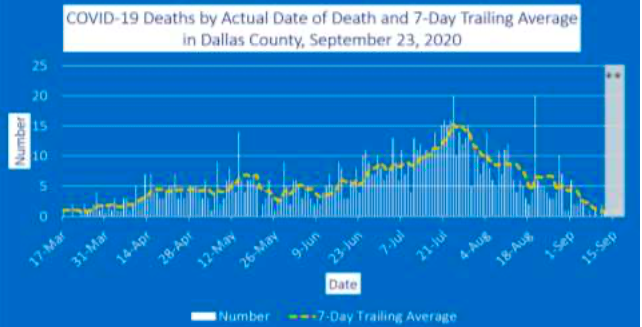
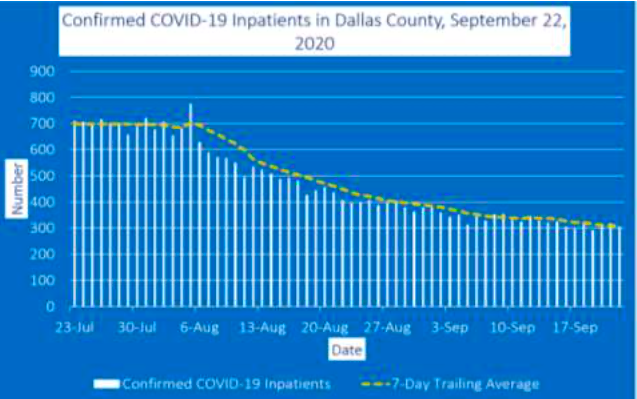
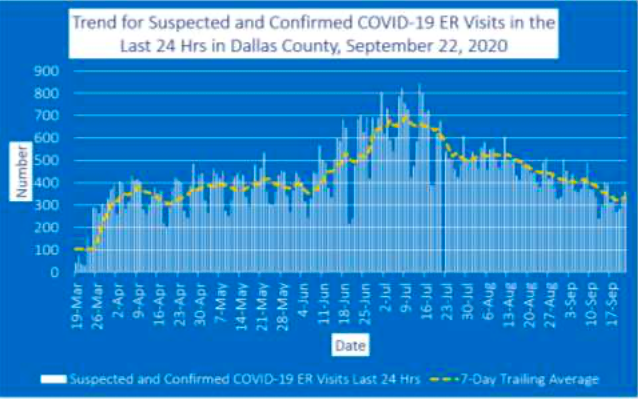
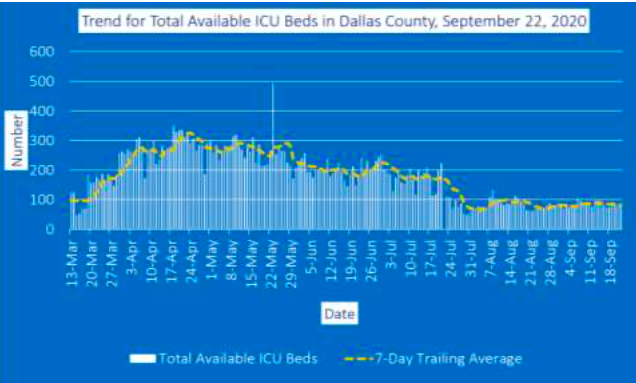
Dallas County reported 306 COVID-19 patients in hospitals Tuesday. Also, the number of emergency room visits for COVID-19 like symptoms in Dallas County was 361 Tuesday, which represents around 14% of all emergency department visits in the county according to information reported to the North Central Texas Trauma Regional Advisory Council.
“Our hospitalization numbers have stopped their decrease and have been largely flat over the last few days. The increases in infection in Tarrant County and the increasing openings of bars under loopholes made possible by Governor Abbott, along with more schools opening, means that we all need to be on our toes in making smart decisions. Unfortunately, bars have been linked to spread in most states, including Texas, and the local Public Health Committee is strongly discouraging frequenting bars at this time,” said Dallas County Judge Clay Jenkins.
A provisional total of 179 confirmed and probable COVID-19 cases were diagnosed in school-aged children between 5 and 17 years of age during the week ending Sept. 12, an increase from the previous week for this age group. The percentage of cases occurring in young adults aged 18 to 22 years has increased to 14% for the month of September.
Since Aug. 20 and as of Sept. 23, Highland Park ISD has reported two cases of COVID-19 among staff members at Armstrong Elementary, one case in a student at Bradfield, one case in a student at Hyer, one case in a person assigned to the McCulloch Intermediate School/Highland Park Middle School campus, two cases among staff members at Highland Park High School, 27 among students, and eight student cases at the high school cleared to return, as reported on the district’s COVID-19 cases dashboard.
Jenkins also stressed the importance of continuing to follow public health guidance.
“If we continue to wear a mask one hundred percent of the time when outside the home and maintain six-foot distancing while avoiding unnecessary trips and any indoor activity where a mask cannot be worn one hundred percent of the time, then I believe we can get back to seeing improvement. With the increasing capacities at certain businesses and more activities opening up, it will more important than ever that we make these good decisions. We must put the community good over our selfish desire to do those few things that the Public Health Committee continues to recommend against so that we can protect public health, jobs, and get our children back to school safely,” he said.
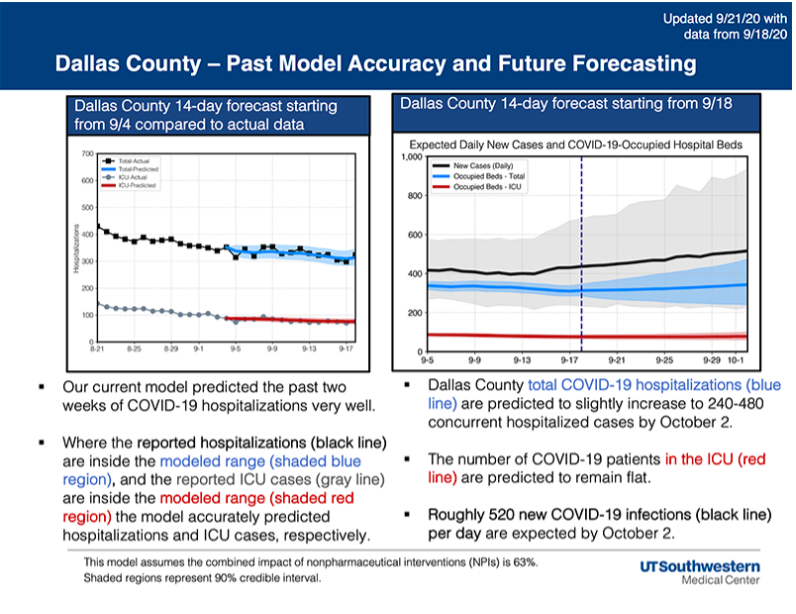
UT Southwestern Medical Center’s latest forecast projects total COVID-19 hospitalizations could slightly increase to between 240 and 480 concurrent hospitalized cases by Oct. 2, and roughly 520 new COVID-19 infections per day are expected by Oct. 2.
The percentage of respiratory specimens testing positive for the virus that causes COVID-19 remains high, the county says, with 10% of symptomatic patients presenting to area hospitals testing positive in the week ending Sept. 12.
SMU Adjusts Fall Operations Assessment Tool
In anticipating COVID-19 cases, SMU developed and followed a Fall Operations Plan, put in place before the semester began, to both care for the campus community and limit the spread of the virus.
The university also utilizes a Fall Operations Assessment Tool to help measure the virus’s impact on the campus population. The weighted measurements of seven criteria add up to an overall score that feeds into the operational level assessment at the bottom of the chart. All that information then guides leadership in decisions about campus operations – decisions that pertain to each of the University’s domains as well as the entire institution.
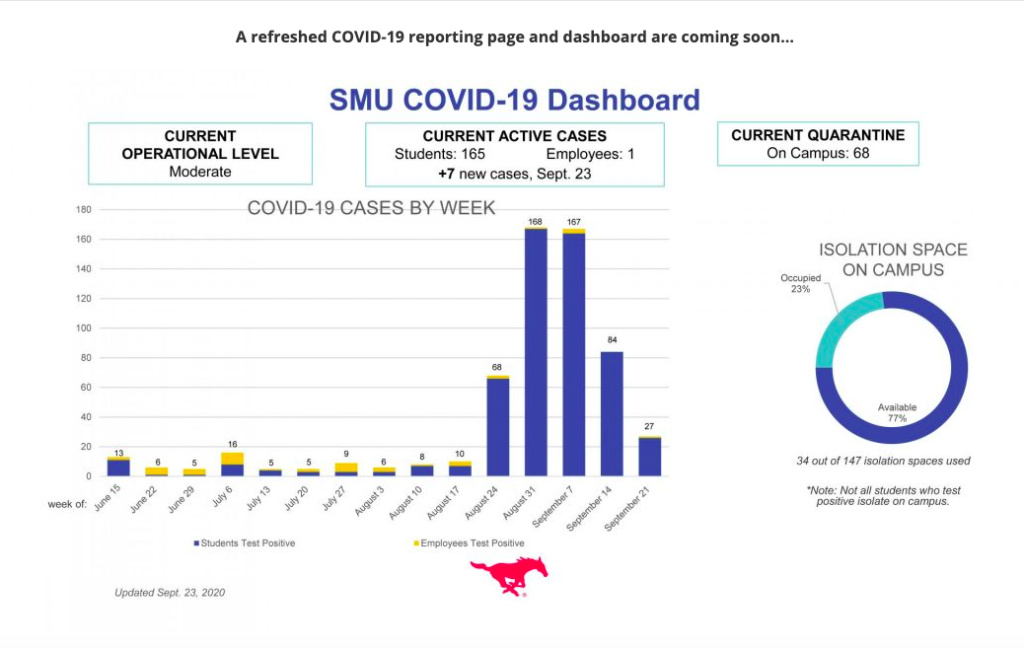
SMU is at the ‘Moderate’ operational level, and has 165 active cases among students and one case in an employee as of Sept. 23, as well as 68 quarantined on campus with 77% of isolation space on campus available, according to the university’s COVID-19 dashboard.
In response to what the university experienced after four weeks of classes, both the assessment tool and the operations plan required adjustment, the university announced Wednesday.
The first change includes calculating the infection rate based on students who are engaged in on-campus activities. The infection rate is calculated by dividing the number of active student positive cases, as is reflected on the Mustang Strong dashboard, by the number of students actively engaged on campus, updating the number of infections among students using data reflecting the entire number of student positive cases, not just those detected through the health center, and more.
The University also announced it secured additional apartment-style spaces near campus, raising their total isolation capacity from 127 to 147 units.
The numerical values for each assessment criteria, such as the ones mentioned above, are totaled to determine an overall “score.”
Adjustments in the assessment tool and their values also necessitate modifications to the operational levels at the bottom of the chart. The four operational level categories will still range from “low” to “very high,” and the total score will still guide (not direct) the President’s Executive Council in determining which level best reflects the campus situation and individual activities within and across each of the domains.
“There are no automatic triggers built into this approach, and, regardless of point value, the “very high” level that would likely result in total virtual learning and reduced staffing on campus could be activated at any time by a state or county order, or by the University president,” the university noted in an announcement.
Red Cross Blood Donors May Help Patients Fighting COVID-19
Plasma from whole blood donations made through the American Red Cross that test positive for COVID-19 antibodies may be able to help coronavirus patients in need of convalescent plasma transfusions. Donors are encouraged to make an appointment to give blood to help ensure coronavirus patients and others who depend on transfusions have needed blood products this fall.
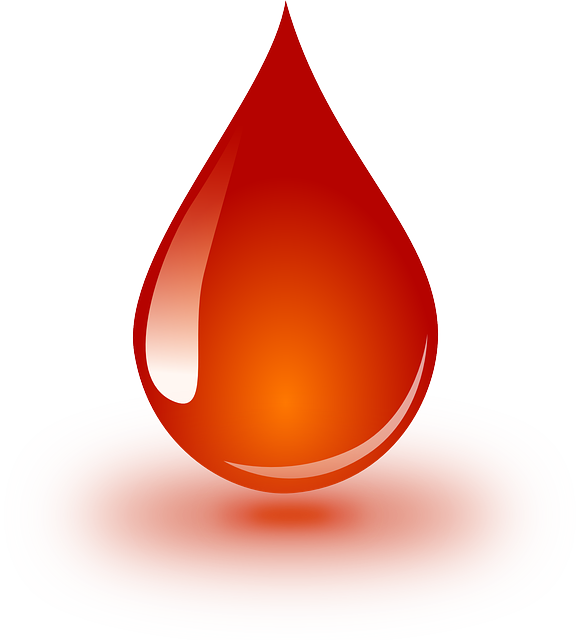
In April, the Red Cross began collecting COVID-19 convalescent plasma from previously diagnosed individuals, who could only give at one of approximately 170 Red Cross blood donation centers across the country. Convalescent plasma contains COVID-19 antibodies that may help the most critical patients actively fighting this virus. Now, whole blood donations made at any Red Cross blood drive or blood donation center could be helpful in this effort.
“Donations that come back positive for COVID-19 antibodies now undergo secondary testing to confirm antibody results, and that enables the Red Cross to then potentially use the plasma from those donations for COVID-19 patients,” said Dr. Erin Goodhue, executive medical director of direct patient care with the Red Cross Biomedical Services. “With approximately 2% of the U.S. population testing positive for COVID-19 antibodies, every donation is important to ensure patients with coronavirus have access to every treatment option available to them.”
The Red Cross encourages eligible individuals to schedule an appointment, download the free Blood Donor App, visit RedCrossBlood.org, call 1-800-RED CROSS (1-800-733-2767) or enable the Blood Donor Skill on any Alexa Echo device.
In thanks, the Red Cross is offering a $1,000 Amazon.com Gift Card to five lucky winners who come to give in October. Terms and conditions apply; visit rcblood.org/unite. Additionally, those who come to give by the end of September will receive a free haircut coupon by email to participating Sport Clips Haircuts locations. More information is available at RedCrossBlood.org/Sport-Clips.





